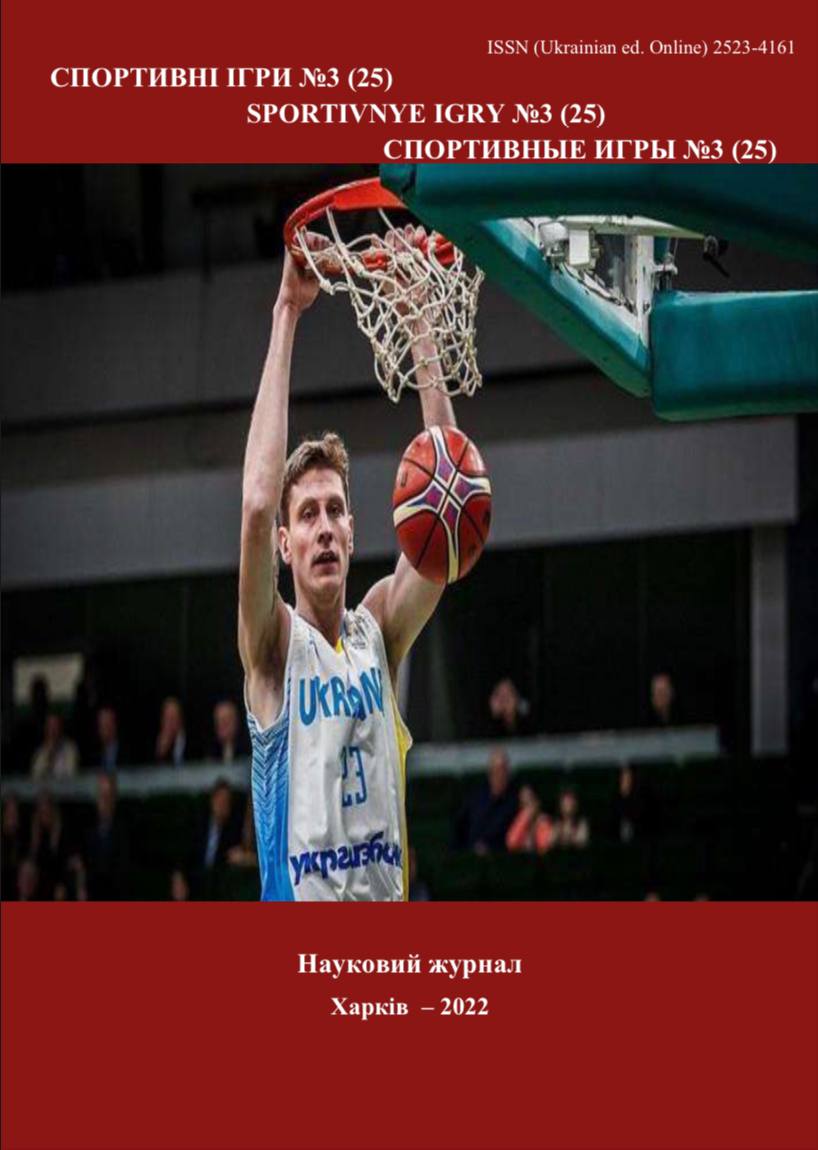Complex development of physical qualities of boys of 10‒11 classes by means of modules of sports games on physical culture
DOI:
https://doi.org/10.15391/si.2022-3.04Keywords:
physical culture, sports modules, educational standards, boys of 10-11 classesAbstract
Objectives: the use of sports modules in physical
education lessons for boys 10-11 grades; to identify the dynamics of development of physical
qualities of boys during the 2017-2021 school years. Material and research methods. The study
involved boys aged 15‒17, who were engaged in physical education classes at the Physics and
Mathematics Lyceum at LNU Ivan Franko, Lviv (October 2020 ‒ May 2021). 15 educational
standards were identified, which were used by the teacher in his lessons during 2017-2021. The
following modules were used in physical education classes in different years: "volleyball",
"athletics", "football", "basketball", "gymnastics", "badminton", "ultimatum". Results of the
research. The analysis of work journals of physical education teachers allowed us to identify
indicators of readiness of students (boys) 10-11 grades (15-16 years). High and sufficient levels of
competence of students according to the average value were observed in the results of 11
educational standards: pull-ups on the crossbar (8.69 times); flexion and extension of the arms in
the supine position (32.73 times); lifting the torso to the side (48.73 times); soccer ball juggling
(8.26 times); passing the ball from above in volleyball (16.47 times); acrobatic combination (11.28
times); long jump (212.57 times); shuttle run 4x9m (9.41 s); jumping over the bench in 15 seconds
(25.17 times); lean forward from a sitting position (7.57 cm); squats (44.57 times). Medium and low
level of competence according to the results of indicators students showed from 4 educational
standards: free throws in basketball (from 10 attempts) (1.75 times); throwing the ball into the ring
after a double step (with 5 attempts) (2.59 times); skipping rope in 1 minute (87.02 times); jumping
rope in 30 s (60.25 times). Conclusions. According to the results of the study, we recommend using
different modules in physical education lessons and combining them in one lesson. We recommend
conducting theoretical classes, gaining knowledge about the impact of exercise on the human body,
the development of sports and physical education in Ukraine and the world, the impact of physical
education and sports on human socialization. We recommend conducting student surveys and
introducing the modules that students want to do, as well as introducing formative assessment in
physical education classes.
References
Боднар, І.Р., Стефанишин, М.В. (2015). Ставлення учнів 10-11 класів до нормативів з
фізичної культури. Cutting-edge science: мaterials of the XI International scientific and
practical conference. Sheffild, Vol. 22, 23-27.
Деревянко, В.В., & Коломоєць, Г.А. (2019). Збірник програм гуртків, факультативів, курсів
за вибором із фізичної культури. Київ: Літера ЛТД.
Дятленко, С.М. (2011). Фізична культура в школі: 5-11 класи: метод. посіб. Київ: Літера ЛТД.
Ільницька, Г.С., Ільницька, Л.В., & Ільницька, С.В. (2018). Фізична культура. 10 клас. Рівень стандарту. Харків: Основа.
Ільницька, Г.С. (2020). Фізична культура. 11 клас. Харків: Вид. група «Основа».
Навчальна програма з фізичної культури для загальноосвітніх навчальних закладів 5-9 класи. (2017). <https://mon.gov.ua/ua/osvita/zagalna-serednya-osvita/navchalniprogrami/navchalni-programi-5-9-klas> (2021, листопад, 9).
Педан, О.С., Коломоєць, Г.А., Боляк, А.А., Ребрина, А.А., Деревянко, В.В., Стеценко, В.Г.,
Остапенко, О.І., Лакіза, О.М., & Косик, В.М. (2021). Фізична культура. 5-6 класи для
закладів загальної середньої освіти: модельна навчальна програма.
<https://mon.gov.ua/storage/app/media/zagalna%20serednya/Navchalni.prohramy/2021/14.
/Model.navch.prohr.5-9.klas.NUSH-poetap.z.2022/Fiz.kult.5-6.kl.Pedan.ta.in.12.08.pdf>
(2021, листопад, 9).
Римар, О., & Соловей, А. (2013). Оцінювання рівня фізичної підготовленості учнів старших класів. Молода спортивна наука України. Вип. 17, т. 2, 181-186.
Рівень фізичного розвитку підлітків. Ознаки гармонійного розвитку хлопчиків і дівчаток.
(2013). <http://narodna-osvita.com.ua/601-rven-fzichnogo-rozvitku-pdltkv-oznaki garmonynogo-rozvitku-hlopchikv-dvchatok.html> (2021, листопад, 15).
Сороколіт, Н., Римар, О., Соловей, А., & Лапичак, І. (2019). Особливості застосування варіативної складової модульної навчальної програми з фізичної культури у міській і
сільській місцевості. Вісник Прикарпатського університету. Серія: Фізична культура,
, 153-159.
Тимчик, М.В., Алексєйчук, Є.Ю., Деревянко, В.В., Єрмолова, В.М, & Сілкова, В.О. (2017).
Навчальна програма з фізичної культури для загальноосвітніх навчальних закладів 10
– 11 класи. Рівень стандарту. <https://mon.gov.ua/ua/osvita/zagalna-serednyaosvita/navchalni-programi/navchalni-programi-dlya-10-11-klasiv> (2021, листопад, 9













